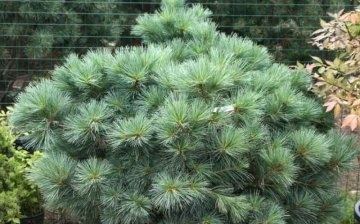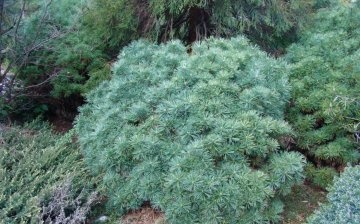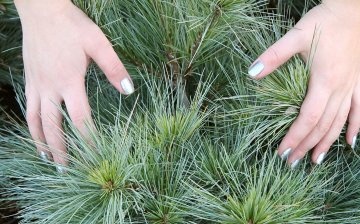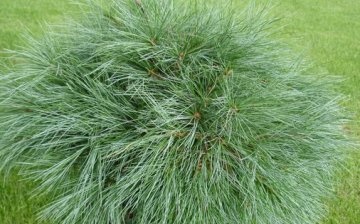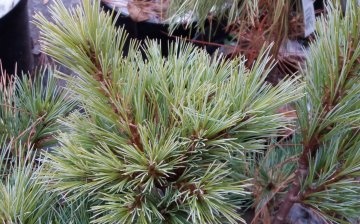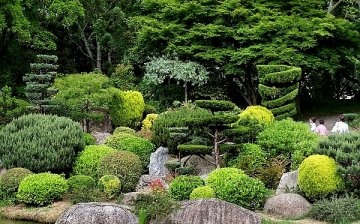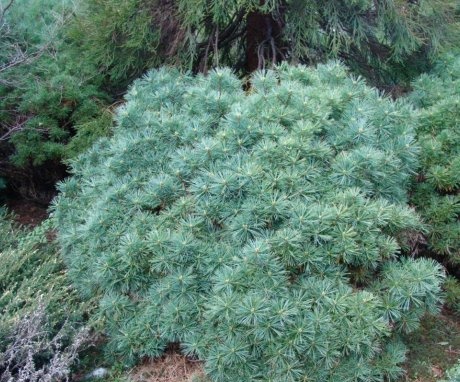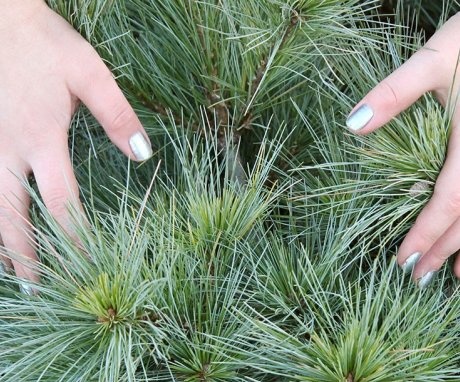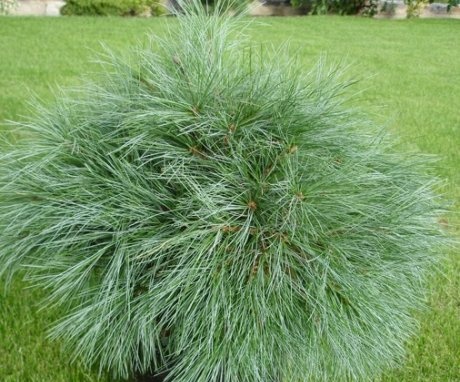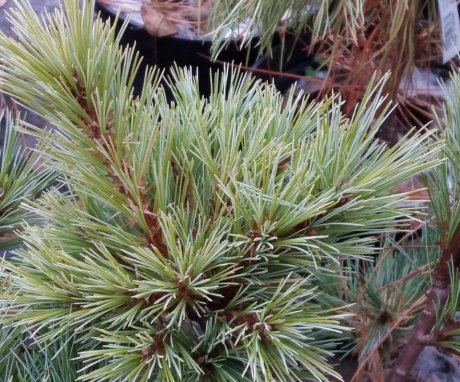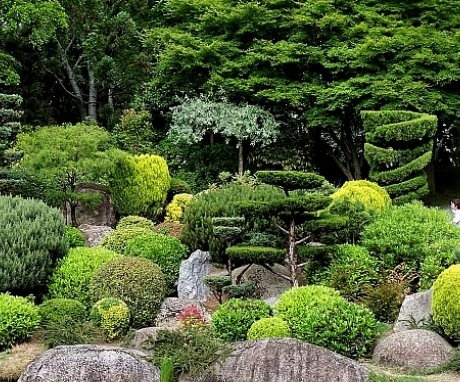Pine Weymouth Blue Sheg: cultivation and use on the site
Weymouth Pine Blue Sheg is very decorative thanks to its compact crown shape and bluish soft needles. It is undemanding to growing conditions, but does not tolerate polluted air.
Content:
- Features and best varieties of Weymouth pine
- The structure of Weymouth Pine Blue Sheg
- Reproduction and planting of pine
- Possible growing problems
- Use of Blue Sheg pine
Features and the best varieties of Weymouth pine
Weymouth Pine (White Oriental) is native to North America. There it grows in mixed forests next to maples, beech, oak. Reaches a height of 30 meters or more. The crown is pyramidal in young years, and with age it becomes almost horizontal. White pine was the first to be brought to the European continent at the beginning of the 18th century by an English lord named Weymouth. He liked her, most likely, for the long, beautiful needles.
The length of one needle can reach 13 cm. The needles are bluish (gray) in color, soft. The bark becomes wrinkled over the years and becomes covered with reddish cracks. Cones appear on 25-year-old trees. They are cylindrical, narrow, slightly curved. Their thickness is about 4 cm, and their length can reach 20 cm. The seeds reach two years after formation, in September.
Many decorative varieties have been created, most of which are notable for their short stature. They all need good drainage:
- Radiata grows up to 3 meters. The needles up to 10 cm long are green with a blue tint. Cones are located in groups of up to 8 pieces each. Dislikes calcareous soil.
- Minima has a bushy shape and a height of up to 1 m. This allows it to be grown in small areas. The diameter of the crown is one and a half meters. After a few years, it takes the form of a pillow. The needles are very tough, green in summer, and acquire a bluish tint by autumn. Grows in sunny areas in moist soil.
- Makopin is a shade-tolerant form with a round crown. Height reaches 1 m. Cones grow in groups of 3. When ripe, they acquire a brown tint. The needles are dense, not hard, bluish in color. Pine grows on sandy loam and loam. It is planted in mixborders, alpine slides.
- The minimum height of 1 m has a crown of one and a half meters. The needles are blue, soft. It can grow on different soils, tolerates a drop in temperature.
- The pendula is distinguished by falling twisted branches. For this she is called weeping. Crohn's irregular shape. The height of an adult tree reaches 4 m, the width is slightly larger. Cones are brown with a purple tint. The needles are bluish.
- Fastigiata reaches 15 m with a width of 2 m. The branches grow upward. The needles are green, the cones are short, up to 3 cm, gray-brown. Doesn't require any special growing conditions other than good drainage. It can grow in a gas-polluted area, does not get sick.
The structure of Weymouth Pine Blue Sheg
Blue Sheg grows a little more than a meter. The crown has the shape of a ball or a wide pyramid, its width is about one and a half meters. The length of the shoots is about 15 cm. The needles are green-blue, not prickly, growing in bunches, each of which contains from 3 to 5 needles, hanging slightly downward.
Cones are long, conical, pale brown in color.
Root system core pines. It can grow on almost any soil. It does not have special requirements for the amount of sunlight and moisture, but it grows better in sunny areas with moist soil. Does not like the city's polluted air.
Reproduction and planting of pine
Most often, Weymouth pine reproduces seeds... But at the same time, the varietal characteristics of the hybrids are not transmitted. For reproduction, Blue Sheg is often used inoculation... The most popular propagation method is cuttings, which are almost never used, because cuttings do not take root well even after rooting. You can use the two methods alternately. First, seedlings are grown from seeds, then they are grafted using cuttings of a varietal tree.
Seeds remain viable for up to 2 years. At low temperatures, they can lie for up to 15 years. Before germinating, the seeds must pass stratificationbeing in moist soil at a temperature of about 4 ° C for at least 2 months.
More often the seeds are sown under the snow. Prepare the soil by adding peat and sand to 3 parts of leafy earth. Sow seeds over the soil surface. Sprinkle a little with soil. They germinate in the next or third year. Set outdoors so that the snow covers the utensils with the sown seeds.
If the climate is unstable, frequent temperature fluctuations are possible, it is better to stratify the seeds and plant them in boxes in the spring.
Seeds germinate at a temperature of about 20 ° C. They are watered moderately, shaded from direct sunlight. In the second year, the apical shoot develops, and the third one begins to form lateral ones. Then it can be planted in a permanent place. A pine sapling usually tolerates transplanting well. When buying pine, you need to pay special attention to the condition of the root system. It should be closed, or at least damp and wrapped in a cloth.
Features of planting pine:
- They dig a hole 1 m deep. A 20 cm high drainage layer is laid on the bottom. Sand or fine gravel can be a good material.
- It is planted by transshipment, protecting the roots from drying out.
- To keep moisture in the soil longer, the trunk circle is mulched compost, mown grass, straw. But such mulch in winter can become a haven for mice. Therefore, in late autumn, this layer is removed, and sawdust or spruce branches are laid.
The crown of a pine is formed in 5-7 years. Pine Blue Sheg does not tolerate drought well. During such periods, it needs to be watered and sprayed with water. In the south and in the middle latitudes, the Weymouth Blue Sheg pine easily tolerates frosts. It belongs to the 4th zone of frost resistance, which extends to the northern regions of Scandinavia. You need to cover it, but not from frost, but from sunburn, which a pine tree can receive in early spring.
Possible growing problems
The most dangerous disease of Weymouth Pine Blue Sheg is blister rust (resin cancer, seryanka). It is a fungal disease caused by a rust fungus. It can be seen by the orange bloom on the needles. After the first signs of the disease are noticed, you need to remove the affected branches. If the lesion has spread, destroy the entire plant. Fungi-causative agents of the disease live on currants and gooseberries, which do not die from them, but are intermediate hosts. Therefore, it is recommended to remove such bushes from the site.
In the spring, blue Sheg pine is preventively treated with preparations containing copper:
- HOM
- Oxyhom
- Cuproxat
- Speed
Pine Blue Sheg is less affected by pests than Crimean or common. Yet their number is large. Some insects are damaged by needles:
- Red-headed sawfly weaver. Its wings are colored blue. The head of the female is red, the head of the male is black. Caterpillars eat needles and form nests from cobwebs and remnants of over-etched food. In July, the larvae descend to the ground, where they pupate until the next spring.
- Pine scoop, gray-brown butterflies with a wingspan of about 3 cm.In March, they lay their eggs on the underside of the needles. The caterpillar is green, with 5 white stripes on top and an orange stripe on the side, eating young needles.
- Brown pine aphids settle on young shoots with the help of ants. Extracts juices from needles and young shoots.
- Pine hermes is one of the types of aphids with a complex type of reproduction. It can be seen by the white hairs on the body. Hermes feed on pine needles juice.
- A pine birch bug crawls into cracks in the bark, after which yellow spots can be seen in places of accumulation. They turn brown over time. The bug weakens the plant, the needles turn pale, fall off.
- Pine fusiform scale insects are immobile insects that settle on needles and suck juice from them. Eggs are laid throughout the growing season. The next year, mobile larvae emerge from them. They spread throughout the tree.
- The gray-haired pine weevil and the large pine weevil cause great harm to the pine tree, nibbling all parts of the plant. The larvae that emerge from the eggs in the ground damage the roots. Especially dangerous large weevil, gnawing the bark in a ring. This causes the branches to dry out.
- Shootworm - butterfly, caterpillars which is damaged by the shoots of young pines. They are curved, several peaks are formed near the tree. The wintering shoot is especially dangerous for Weymouth pine - a butterfly with yellow front wings, on which silvery stripes are noticeable. The wingspan is about 20 mm. Caterpillars hibernate in damaged buds, covered with cobwebs. You can fight them by spraying with insecticides: Confidor or Aktara.
- Dotted resin is a beetle up to 7 mm long. Damages all parts of the plant. Thick larvae dig holes in the bark. They are treated with preparations containing bifenthrin.
Use of Blue Sheg pine
Weymouth Pine Blue Sheg is grown in any illuminated areas, in the foreground of tall shrubs. They are planted in alpine and rocky flower beds, heather gardens, used to create original compositions.
You can create loose hedges from it. The advantage of Blue Sheg pine is its small size It can be planted on balconies and loggias, patios
Staying green all year round, it will constantly decorate the site, while deciduous trees will shed their foliage.
Planted separately, the Blue Sheg pine will draw attention to itself. Can be planted with other small conifers with contrasting needles and short needles.
More information can be found in the video:



